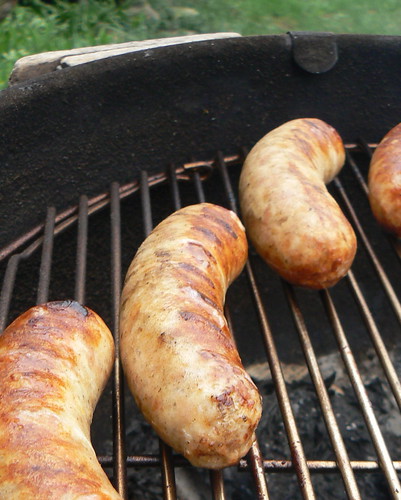
When it comes to the dueling sausages of our house, it's Bratwurst vs. Parsley and Cheese. Usually the P&C wins(Bonne Femme's fave), but this week I had a hankering for for my German friends.
I started to think about it on the way back from my food styling class last Saturday: A nice day, grilled sausages, sauerkraut, some mustard. It's not too much trouble to put together a couple pounds of sausage, right? Chicken Again?
Chicken Again?
I used chicken in this recipe because that's what I had on hand. As I have mentioned in previous chicken sausage posts, I start the week with one whole chicken. The first thing I do is bone it and make stock with the bones. I get about a quart of stock from one chicken. Next I use the chicken during the week for whatever, nuggets for the boys, chicken salad, pot pie. By the end of the week if there is any bird left it ends up on pizza or sausage. Enough life lessons, let's go to the boards:
Chicken Bratwurst
989 g (2 lb 3 oz) Chicken, cubed
18 g Salt
1 g ginger, ground
1 g nutmeg, ground
1 g caraway seed, ground
2 g marjoram, dried
10 g powdered milk
Milk or water.
Combine chicken with dry ingredients, allow to marinate for one to four hours, if you have the time, in the fridge. Grind with using the small plate into a chilled bowl. Using a really big wooden spoon stir this mixture and add no more than 125 ml (1/2 cup) or milk or water. Continue stirring until it starts to come together, about 1 minute. Stuff into hog casings, twist into links. Allow sausages to rest, uncovered, in the refrigerator, if you have time. If not, go ahead and grill over indirect heat until done.
Yield: About 8 - 6 inch sausages.
A word about chicken and fat.
I first learned about making sausage from the book Charcuterie, by Michael Ruhlman and Brian Polcyn. Their primer on sausage making stresses the importance of added fats, especially in lean meats such as chicken. I followed the advice of the book religiously, until one day I wanted to make sausage but I didn't have any additional fat. You know what? It turned out great. The Bratwurst recipe above does not call for added fat, however when I said I used a whole chicken the means not only meat but also, skin and fat (okay not giblets, but why not?). And it tastes great. I think the milk powder helps retain moisture so the added fat's only job is to keep it juicy once the sausage has been overcooked (Note: Don't overcook your sausage). My point here is not that I'm not out to create a "Lo-Fat" sausage (My mom calls me butter boy), but that to make sausage at home does not require a special trip to the packing plant: I got my bird out of the cold case, I got the casings ("oh about six feet please") by asking the man behind the meat counter at Walt's. Try it, homemade tastes way better than anything you'll get on a Styrofoam tray. (I'm spouting off again.)

Get out and grill, and be happy.
Cheers.


4 comments:
Looks really good-great texture as well. I probably would follow your no added fat chicken sausage recipe, but unfortunately, I just picked up 15 lbs. of fatback just waiting to be added to sausage and rendered into lard.
cooked rice makes an excellent fat substitute, 1 to 1 on a weight basis. I have had a low fat Italian made with 4 pounds lean pork and 1 pound cooked rice, picked up the recipe from a sausage class at CIA.
That class and Ruhlman and Polcyn have had me making all my sausage for a couple of years now.
This is cool. I wanted to try a plain old chicken sausage using thighs because I thought the fat content would be adequate, but was reluctant since the whole craft seems somewhat centered on the 25% fat element. I can't wait to try these. Just have to track down some hog casings tomorrow and I'm off!
I've done a chicken thigh sausage directly out of either Charcuterie or the CIA's Garde Manger. It was excellent.
Have to do that one again and soon.
Post a Comment